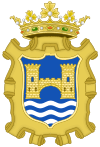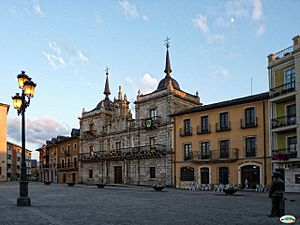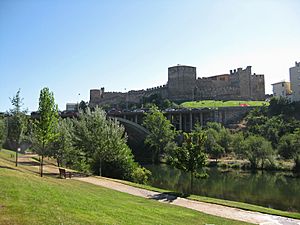Ponferrada facts for kids
Quick facts for kids
Ponferrada
|
|||
|---|---|---|---|
|
|||
| Country | Spain | ||
| Autonomous Community | Castilla y León | ||
| Province | León | ||
| Region | El Bierzo | ||
| Founded | 11th century | ||
| Area | |||
| • Total | 283 km2 (109 sq mi) | ||
| Elevation | 544 m (1,785 ft) | ||
| Population
(2005)
|
|||
| • Total | 65,984 | ||
| • Density | 233.15/km2 (603.9/sq mi) | ||
| Time zone | UTC+1 (CET) | ||
| • Summer (DST) | UTC+2 (CEST) | ||
| Postal code |
244xx
|
||
| Area code(s) | 987 | ||
| Website | www.ponferrada.org | ||
Ponferrada is a city in Spain. Its name comes from the Latin words Pons Ferrata, meaning "Iron Bridge." It is the main city of El Bierzo in the Province of León.
Ponferrada is located on the Sil River and is surrounded by mountains. It is the last big town on the French route of the famous Camino de Santiago pilgrimage. Many people walk through Ponferrada on their way to Santiago de Compostela. In 2008, about 69,769 people lived here.
Contents
History of Ponferrada

Long ago, before the Romans arrived, the area was home to the Astures. They were a group of people from the Gallaecian culture. The Roman Emperor Augustus conquered them around 29-19 BC.
After the Romans took over, Ponferrada became a huge mining center. They dug for gold and other metals. You can still see many Roman mining sites today. One of the most amazing is Las Médulas. It's so important that UNESCO made it a World Heritage Site in 1997.
The Romans also brought grapevines to the region. Wine making became very popular. However, in the late 1800s, a tiny insect called Phylloxera destroyed most of the vineyards.
The city's modern name comes from an old bridge. In 1082, Bishop Osmundo of Astorga ordered iron to be added to the bridge over the Sil River. This made it easier for pilgrims to cross on their way to Santiago de Compostela. That's why it was called the "Iron Bridge" (Pons Ferrata).
The railroad reached Ponferrada in 1881. During World War I, people started mining tungsten here. Tungsten was used to make weapons. In 1918, a company called Minero Siderúrgica de Ponferrada (MSP) was started. It mined coal and became Spain's biggest coal mining company.
Later, in 1944, the Spanish National Energy Corporation (Endesa) was founded. In 1949, they opened Spain's first power plant that used coal in Ponferrada. It was called Compostilla I. By the 1960s, the city's economy mainly relied on mining and making electricity. This electricity came from both water power and coal.
In the late 1980s, most of the mines closed. This caused a difficult time for Ponferrada. But in the late 1990s, the city started to change. New businesses came, and wine production began again. A branch of the University of León also opened. The city's roads and services improved a lot.
Today, Ponferrada's economy is mostly based on tourism, farming (especially fruit and wine), wind power, and slate mining. The number of people living in the city is slowly growing.
Tourism has grown a lot recently. This is because more people are walking the Way of St. James. Also, Las Médulas became a UNESCO World Heritage Site in 1997. Many new places for tourists to stay and wineries have opened. The Energy City Foundation was created in 2006. It is building the National Energy Museum in the city. This museum will help bring even more tourists and boost the economy.
What to See in Ponferrada
Ponferrada is a stop on the Way of St. James. This is a UNESCO World Heritage Site. Many pilgrims walk through the city on their journey to Santiago de Compostela. Las Médulas, which are ancient Roman gold mines, are also a UNESCO World Heritage Site. They are just a few kilometers from the city.
The Templar Castle
Ponferrada is famous for its Castillo de los Templarios, or Templar Castle. It covers a huge area, about 16,000 square meters. In 1178, King Ferdinand II of León gave the city to the Templar order. Their job was to protect the pilgrims walking the Way of St. James.
The castle was home to the Templars' main leader in Castille. But the Templars only had the castle for about 20 years. Their order was ended, and their properties were taken away in 1311. After that, different noble families fought over the castle. Finally, in 1486, the Catholic Monarchs took control of Ponferrada and its castle.
Over time, many stones from the castle walls were used to build other things in the town. But now, a lot of work is being done to restore the castle.
Other Interesting Places
- The Basilica de la Encina is a church built in 1573. Its tall, fancy tower was added in 1614.
- The El Bierzo Museum shows the history of the region. It has many important old objects.
- The Museum of Radio tells the story of radio in Spain.
- The National Energy Museum is being built. It will include the old Compostilla I power plant, which was Spain's first coal-fueled power plant.
- Nearby, you can visit the church of Santiago de Peñalba. It's a great example of Mozarabic art. There's also the Hermitage of Santo Tomás de las Ollas from the 10th century. The Romanesque Church of Santa María de Vizbayo is also close by.
- For the best view of the city, visit the Torre de la Rosaleda. It's the tallest building in Ponferrada.
Culture and Education
Ponferrada has many schools for primary and secondary education. There's also a public language school where you can learn English, French, German, Portuguese, and Galician.
The city also has a campus of the University of León. Here, students can study for different college degrees. There's also a UNED branch for students who want to study from home.
You can often see Theatre shows at the local Teatro Bergidum. There's also a movie theater with seven screens. Besides the El Bierzo Museum and the Museum of Radio, the National Energy Museum is being built.
Every year, Ponferrada hosts music and cinema festivals. It also hosts the annual Golden Microphone (Premios Micrófono de Oro) award ceremony. These awards honor the best radio professionals in Spain.
Images for kids
-
Library of the University of León's campus in Ponferrada.
-
El Toralín, the home turf of SD Ponferradina.
See also
 In Spanish: Ponferrada para niños
In Spanish: Ponferrada para niños










